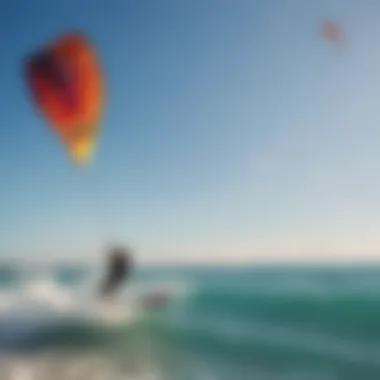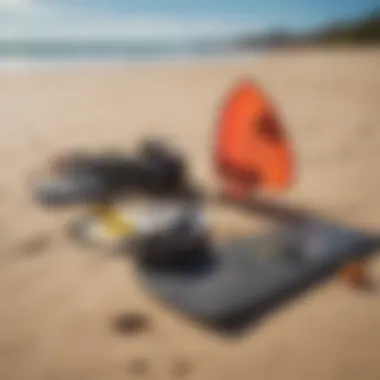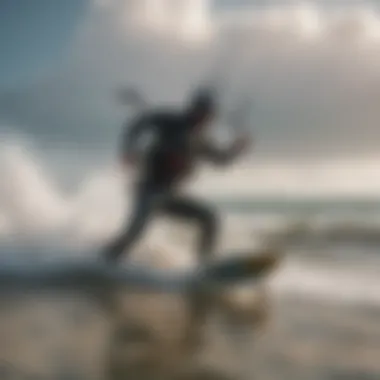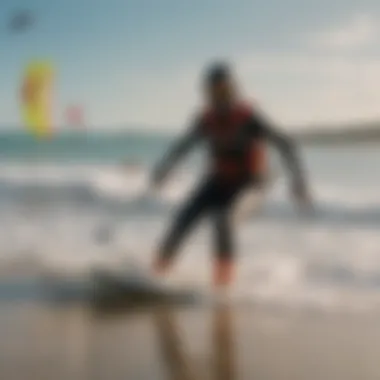A Comprehensive Guide to Mastering Kitesurfing Skills


Intro
Kitesurfing is a thrilling pursuit that draws many enthusiasts. Understanding the fundamental aspects, from essential equipment to safety measures, is crucial for gaining competence in the sport. This guide aims to present valuable insights and information, making learning about kitesurfing a more engaging experience.
Equipment Reviews
Kites
The kite is the heart of kitesurfing. Modern kites come in various shapes, sizes, and materials. Popular kite models include those designed for light wind and heavy wind conditions. For example, the Cabrinha Switchblade offers versatility, while the Naish Pivot is favored by many for its performance in diverse settings. Understanding kite shapes like C-shape, delta, and bow kites can aid in selecting the right one for specific riding styles.
Key features to consider in kites:
- Material: Durable materials can enhance longevity.
- Aspect Ratio: Influences speed and lift potential.
- Wind Range: Matching the kite's capability to prevailing wind conditions is essential.
Boards
The next essential piece of equipment is the board. Kitesurfing boards can generally be categorized into two main types: twintips and directional boards. Twintip boards are great for beginners due to their symmetrical structure, making tricks and landings more intuitive. On the other hand, directional boards suit advanced riders who enjoy surfing waves.
Factors to evaluate while choosing a kiteboard include:
- Construction: Materials impact weight and durability.
- Riding Style: Shorter boards may be more maneuverable, while longer ones provide stability.
- Size: The board size should correlate with the rider's weight and wind conditions.
Accessories
Vital accessories can greatly enhance the kitesurfing experience and safety. Harnesses allow for effective energy distribution while riding. Different harness styles—seat and waist styles—appeal to varied preferences in comfort.
Essential accessories also include lines, pumps, and safety gear such as helmets and impact vests. Each accessory plays a role in improving ease and protection while kitesurfing.
In summary, investing in quality gear and understanding its features deeply influences performance and enjoyment in kitesurfing.
Prologue to Kitesurfing
Kitesurfing is more than a mere pastime; it is an invigorating sport that combines elements of windsurfing, surfing, and paragliding. The significance of understanding kitesurfing goes far beyond the thrill of gliding over water. It involves grasping the principles of wind power, mastering aerial maneuvers, and, most importantly, ensuring safety on the water. For those pursuing kitesurfing, the grasp of essential concepts can greatly influence their overall experience.
As kitesurfing continues to gain popularity across the globe, so does the necessity for beginners to familiarize themselves with its foundational aspects. This unfolds an array of potential benefits, not only enhancing one’s skills but also improving safety awareness. An informed approach to kitesurfing leads to greater enjoyment and reduces risks associated with the sport.
Understanding Kitesurfing
Kitesurfing primarily involves harnessing the power of the wind to propel a rider on a board across the water. This sport integrates various components including a kite, a harness, and a board. The kite serves as the primary propulsion source, while the board acts as the rider's platform for maneuvering on the water surface. Deft kite handling and board control are essential skills for every kitesurfer, offering both challenge and sheer exhilaration.
A key factor in kitesurfing is understanding the dynamics of wind. Factors such as wind speed, direction, and turbulence play roles in achieving optimal performance. Beginners often find it daunting to master these principles, however, with an informed mindset and dedicated practice, it becomes manageable.
Historical Context of Kitesurfing
Kitesurfing’s roots can be traced back to methods of propulsion using kites, optimizing natural forces for good use. Early versions of kites were utilized for various purposes, from fishing to transport before evolving into an extreme sport in the late 20th century. The modern form of kitesurfing emerged in the 1970s when inventors like Jean-Claude Fuchs and the Lei family introduced innovative ideas, such as the use of inflatable kites.
The sport gained traction notably in the 1990s, birthed by the introduction of kite boarding. This period saw a convergence of various water sports methodologies, slowly inviting more participants into forward-tipleside lõcles. The evolution of material technology subsequently improved kite design and performance, offering more stable and efficient options for riders.
The journey of kitesurfing is telling, revealing how it has preserved essential aspects related to wind and water around the world, inviting a rich community of enthusiasts that spans borders and cultures. Understanding this context sheds light on how kitesurfing operates beyond mere recreation. معرف álobig org
_
Essential Gear for Beginners
Before one can excel in kitesurfing, selecting the right equipment is crucial. Beginning this sport with appropriate gear enhances safety, improves performance, and maximizes the overall learning experience. The equipment you choose can significantly influence your ability to develop skills effectively and confidently. Therefore, understanding what each item offers is essential for anyone wanting to venture into the world of kitesurfing.
Kite Selection
Choosing the correct kite is the first and most important step for beginners. Kites come in various shapes, sizes, and types, each designed for specific wind conditions and skill levels.


- Type of Kite: Most beginners will opt for a leading edge inflatable (LEI) kite due to its stability and ease of use. These kites provide good power delivery and are suitable for various weather conditions.
- Size Matters: The size of the kite is also vital. Beginners generally perform better with larger kites that are easier to control in lower winds. Historically, kites of sizes ranging from 8 to 12 meters are preferred.
- Wind Range Considerations: Understanding wind ranges for kites will enable you to select a kite that stays within manageable conditions for learning.
Each preference and local conditions vary, meaning beginners should consult local experts or instructors. Manufacturers like CABRINHA and SLINGSHOT provide helpful recommendations based on experience and wind situations.
Board Types and Features
Boards come in a variety of styles and sizes and understanding these differences is vital.
- Twin-Tip Boards: Update for the beginner’s selection as these boards offer stability and are user-friendly. They allow the rider to go both ways easily.
- Directionals: Such boards are for more advanced riders. They are designed specifically for one direction and offer a different kitesurfing experience, adding skills and dimensions but are generally not recommended for those just starting.
- Board Size: Bigger boards are ideal for beginners mainly for surface area which keeps you up on the water. Those with a greater volume ride smoother, making them forgiving in variable conditions.
Research brands such as NORTH and RRD to find a board that aligns with your style is essential.
Safety Equipment Overview
In a sport such as kitesurfing, safety cannot be overemphasized. Wearing the right safety gear enhances protection against potential hazards.
- Helmet: Essential to protect your head from impacts; a comfortable fitting is vital to ensure it stays secured during activity.
- Impact Vest: Another smart addition, a vest can protect your body from the surf and provide necessary flotation.
- Leashes: Using a board leash prevents the board from floating away in windy conditions which can be essential for saving time and frustration. Makes recovery easier.
Lastly, take note of local guidelines regarding safety regulations in the area where you intends to kite.
Remember, choosing good equipment is the most valuable investment you can make. Proper gear provides safety, enhances performance, and gives you the confidence to enjoy this thrilling lifestyle.
Basic Techniques to Learn
Understanding the basic techniques of kitesurfing is crucial for anyone entering this exhilarating sport. These skills form the bedrock that allows progression in more advanced maneuvers and greater enjoyment while on the water. Without mastering these fundamentals, any attempt to advance can lead to frustration or accidents. Thus, investing time in comprehending basic techniques is a necessity.
Kite Control Fundamentals
Kite control is reallly essential as it influences how effectively a kitesurfer can maneuver and fly their kite. The first aspect to focus on is learning how to launch and land the kite safely. A moisture-free and short preparation before launching can prevent equal catastrophe. controllong the traction on the bar sets the groundwork for speed and jump, which are significant components in kitesurfing.
One must practice with different wind conditions. This develops a better feel for the kite's responses. Appearing thresholds are crucial, as they indicate when control is maximum, thus generating top speeds. Practicing gentle steering versus harsh manuevers creates an adjusted perception. Incrementally venturing through basic adjustments leads to huge benefits in later stages.
Tips for Kite Control:
- Practice launching in 5-15 mph winds for a rawer feel.
- Be cautious with traction; control means precision.
- Use your body to direct the kite, not just the bar.
Getting Up on the Board
Getting up on the board while kitesurfing turns challenging movements into achievable tasks with practice. This technique establishes balance and foundation for anything that will follow it. It demands coordinated effort between the kite, your body and the wind itself.
A common approach begins with the kite positioned in the power zone. Pulling on one side of the bar slightly while allocating weight onto the board gauges up and into position. Focus on creating alignment between your body weight, board position, and normal kite position. Early mistakes often include leaning back too far or failing to fully use the power of the kite.
Achievements are often marked initially by simple conversation.“I got up” can be transformed to a magic like feeling. Completing this step may depend on the final make of onboard traction and steady composition.
Helpful Steps to Get Up:
- Ensure the kite remains steady in its power zone.
- Pull on the back leg for a more enhancded acceleration.
- Keep looking forward while utilizing a straight head position.
Water Starts Explained
The act of water starts signals a crucial movement when a kitesurfer learns to transition from water to the board while attached to the kite. This seamless shift exhibits confidence in harnessing the kite’s intended lift and true navigation mastery.
Starting with the kite situated on 1 o'clock, the strong pull initiates by creating resistance against water used to tranform positions. In this step, the surfer must yell the inertia generated towering above it. Timing bne strain is critical. Jumps just end linguistic losses when amplifying bounce frequency into midair.
Developing a fine awareness about every transition signifies steadiness. Lifespan becomes much hassle as endeavors accumulate towards natural kitesurfing. Dissolving starting behaviors indicaates open power response.
Important Note for Water Starts:
- Maintain constant tension in the lines to ensure the kite's precise performance.
- Make gradual weight shifts and avoid twisting the body excessively.
It is through these fundamental techniques that kitesurfers can enhance their unforgettable riding experiences . Free wit midst passion allows built purpose yet forms a connection intuition with sport around equipped adventures.


Safety Protocols and Practices
Safety is of utmost importance in kitesurfing. Rigorous adherence to safety protocols and practices can mean the difference between an exhilarating experience on the water and one that leads to injury or danger. Each kitesurfer must prioritize their safety as well as that of others around them. Understanding the local conditions is vital. The ocean and weather can be unpredictable, affecting how safely one can kite. Factors such as wind speed, water currents, and forecasting can decide the risk level when entering the water. Analyzing these variables equips individuals with knowledge that enhances decision-making.
Understanding Local Conditions
Knowing weather patterns and tide schedules can significantly impact a kitesurfer's ability to manage their ride smoothly. Wind direction is also critical; kitesurfers need to familiarize themselves with how local winds can fluctuate. It is advisable to check local resources for real-time information about weather warnings and updates. Be alert to any changes in wind patterns while out on the water. Here are some specific points to consider:
- Wind Stability: Assess whether the wind is steady or gusty. Steady wind provides better control and performance.
- Area Specificity: Each beach might present unique conditions, such as flat water or choppy waves. Research the specific spot before heading out.
- Nearby Kitesurfers: Observe what other riders are doing. Their techniques and reactions provide valuable insight into current conditions.
A comprehensive understanding of local conditions minimizes risks and enhances the experience for all kitesurfers.
Emergency Procedures
Even with careful planning and consideration, accidents can occur. Being prepared for emergencies is crucial for every kitesurfer. Emergency procedures help instill confidence and rapidly address situations if they arise. Here are several important protocols to follow:
- Emergency Signal: Develop a signal to communicate distress clearly with others nearby. This can assist in efficiently organizing aid and support.
- First Aid Knowledge: Familiarize yourself with basic first aid techniques. Bleeding control, resuscitation, and managing sprains are useful skills.
- Buddy System: Always kite with a partner. This adds a layer of safety, allowing someone to lend assistance quickly if needed.
- Device Availability: Identify locations for emergency devices like flares or whistles. These can alert others effectively and quickly.
- Escape Plan: Have a clear exit route established from the water in case conditions worsen swiftly. Knowledge of issues like rip currents and local hazards surfaces crucial.
Being prepared increases your control over any situation. Having procedures in place enhances safety on the water.
Ultimately, mastering safety protocols is a long-term investment for joy and continuity in kitesurfing. Prioritizing safety helps or activate not only skill advancement but lays down the very foundation for enjoyable kitesurfing experiences.
Becoming a Better Kitesurfer
Becoming a proficient kitesurfer involves a commitment to continuous improvement and skill refinement. The process not only enhances your overall experience but also ensures safety on the water. As kitesurfing can be complex, understanding specific progression techniques and recognizing common mistakes is vital. This section will delineate the critical factors that contribute to advancing your kitesurfing abilities.
Progression Techniques
Improving your kitesurfing abilities requires understanding various progression techniques. These techniques can help you transition from basic maneuvers to more advanced skills effortlessly.
Here are some key progression techniques to focus on:
- Practice Frequently: Regular practice solidifies your muscle memory. This leads to a more natural flow when performing tricks.
- Understand Wind Patterns: Learning how to read wind becomes important as you progress. A better grasp of wind conditions aids in controlling your kite more effectively.
- Incremental Challenges: Gradually increasing the difficulty of your practice can foster growth. Start with simple jumps and move onto spins and grabs as you build confidence.
- Video Analysis: Recording your sessions provides feefback that helps identify areas needing improvement. This self-critique can lead to more efficient learning.
Ultimately, focusing on these techniques will help refine your techniques, increase your comfort, and push your limits.
Common Mistakes to Avoid
Continuous improvement involves recognizing pitfalls commonly encountered by kitesurfers. Avoiding these mistakes can drastically enhance both your safety and performance.
Some common mistakes to watch for include:
- Ignoring Safety Protocols: Always prioritize safety equipment, such as helmets and impact vests, regardless of your skill level.
- Rushing the Learning Process: Each kitesurfing skill builds upon the previous one. Rushing may endanger your safety and prevent solid feedback cycles.
- Neglecting Physical Fitness: Kitesurfing demands physical strength and endurance. Staying fit enhances control and agility.
- Not Considering Environmental Factors: Failing to account for wave and wind conditions can lead to challenges on the water.
Doing the same routine without monitoring progresses can lead you backward. Stay mindful of your training.
Awareness of these common pitfalls, along with a focus on effective progression techniques, provides a balanced approach to becoming a competent kitesurfer. Both play an essential role in fully realizing and enhancing your potential in the kitesurfing arena.
Kitesurfing Communities and Resources
Kitesurfing is more than just a sport; it is a way of life that often leads to forming strong communities. Being part of such a community offers numerous benefits, enhancing your overall kitesurfing experience. Kitesurfing communities provide support, encouragement, and shared knowledge among participants of various skill levels. Staying connected with others also creates opportunities for discovering local spots to ride, trade gear, and socialize.
Within these communities, one can access valuable resources that can quickly aid in navigating the learning curve of kitesurfing. These resources might include tutorials, forums, and reviews of gear, all tailored specifically for kitesurfers. They cultivate a collective knowledge base where tips and tricks about techniques can be shared freely.
Furthermore, engaging with like-minded individuals can enrich your learning process. Personal interactions lead to more significant learning opportunities, such as local guidance on weather patterns or wind conditions, which are critical for safe and enjoyable kitesurfing.
Finding Local Schools and Instructors
Identifying a suitable school or instructor is critical for new kitesurfers. Professional instructors offer structured lessons, ensuring that you grasp the key safety procedures and necessary techniques. Schools often provide a rental option for equipment, allowing you to try different styles before making an investment.


When choosing a school, consider the following:
- Reputation and Certifications: Look for schools endorsed by recognized IIK or analogous kitesurfing organizations. Certified instructors tend to offer a reliable standard of training.
- Tailored Programs: Select schools that assess your prior experience and tailor lessons accordingly. Personalized attention is essential for quick progress.
- Student-to-Instructor Ratios: A smaller group size often leads to more effective instruction.
Connect with local schools on social media platforms like Facebook or Reddit, where local kitesurfers often gather to discuss techniques, equipment, and upcoming events. You may retrieve essential insights and experiences from fellow kitesurfers.
Participating in Kitesurfing Events
Joining kitesurfing events provides an excellent platform not merely for skill improvement but also for community engagement and enjoyment. Local competitions, fun runs, or kitesurfing festivals can enhance your riding skills and single out the enthusiasm of the sport.
Advantages of participating include:
- Networking: These events are also a great way to meet others who share your passion. You can build friendships and possibly find long-lasting kitesurfing partners.
- Learning Opportunities: Events usually feature workshops or advanced sessions, giving you direct access to tips and techniques from skilled riders and instructors.
- Motivation: well-situated competitions stimulate progress. Watching others perform can provide a fresh perspective as you mentor innovations into your own practice.
Attending these events can keep the kitesurfing spirit alive. Engaging with the kitesurfing community will inform your journey, encourage progress, and ensure a richer overall experience.
Travel Considerations for Kitesurfers
Traveling to kitesurfing locations presents unique opportunities and challenges that can significantly impact the experience of riders. These considerations go beyond logistics; they delve into the suitability of a destination in terms of wind patterns, wave conditions, and local regulations regarding kitesurfing. For many, traveling to kitesurf frequently enhances skill levels, exposes them to different kite styles, and connects them to a vibrant community.
Understanding travel considerations can unlock the potential for thrilling sessions and advenure. Activities like checking wind forecasts or seeking out favorable beach demographics can enhance not only performance but also provide safety in terms climaat and local knowledge. Additionally, destination selection can determine what type of progression you'll undergo.
When considering where to kitesurf, aspects such as accommodations, availability of necessary equipment, and sources of transport are also paramount. With detailed knowledge on these topics, kitesurfers can anticipate and prevent common travel-related issues, making the journey enjoyable and rewarding.
Best Destinations for Kitesurfing
When selecting the ideal location for kitesurfing, a few destinations have become celebrated for their conditions. Some of the winner locales employ steady winds, warm waters, and supportive kitesurfing communities. Whether you are seeking a calm session or challenging waves, these spots are worth consideration.
- Tarifa, Spain: This Argentine's dream has high wind seasons and competitions. It fuses culture and lifestyle with water sport. Rely on either the Atlantic's wild nature or the Mediterranean elegance.
- Cabarete, Dominican Republic: The north coast offers reliable breezy conditions. Add vibrant nightlife and a local community supportive of kitesurfing.
- Mui Ne, Vietnam: Long-standing around easy winds and warm waters. Calming sunset sessions await. Promises adventure through kitesurfing with some of Asia’s best blend culture immersion.
- Cumbuco, Brazil: Home to large flat lagoons and consistent wind builds. Inviting atmosphere captivates kitesurfers away from city distractions.
All present enchanting adventure but concentrate their expertise on various elements which complement their environment in fit degrees.
Packing and Transportation Tips
Effective packing is key to smooth travels, enhancing the overall trip could improve kitesurfing experience. Knowing what and how to pack ensures you maintain a spectrum of necessities for kiteturfing experience.
- Kite and Equipment: Techniques for disassembly could help save functionality. Using durable clothes and fins protect these items on routes. Traffic mishaps won’t affect high priced gear choosing durable visuals.
- Clothing Based on Environment: Selecting waterly gear accordingly while keeping wind chins and otherwise caring pack for materials considering weather.
- Travel Insurance: Useful particularly for flights and specialized equipment.
Taking proper steps pre and during travels will lessen risky situations for gear maintenance.
Remember: The right preparation can enhance fun-packed kitesurfiby trip, smooth progress potential. Also provides a platform everywhere.
Preparation gain competence to direct needed route as you peddle leisurely surfing.
Epilogue and Future Directions
As we reach the conclusion of this comprehensive guide, it is essential to reflect on your personal growth in kitesurfing and consider the paths ahead. Kitesurfing is not merely a sport; it’s a journey filled with lessons, challenges, and a deepening sense of community. Understanding how to assess your progress and recognize further growth opportunities is critical to becoming a proficient kitesurfer.
Reflecting on Your Progress
Reflecting on your progress involves analyzing what skills you’ve mastered and identifying the areas that require more practice. Keeping a journal can help record specific achievements and challenges encountered during your kitesurfing experience. Here are some essential aspects to consider:
- Rescue skills and safety understanding
- Kite control and maneuverability
- Board starts and riding techniques
- Ability to gauge wind and water conditions
- Understanding of equipment maintenance
To create a more structured approach to reflection, you may find it helpful to set personal milestones alongside an annual goal. Revisit these goals periodically to measure your progress. Over time, this awareness not only enhances skill level but also cultivates confidence, a quality vital for kitesurfing.
Continuous Learning in Kitesurfing
The landscape of kitesurfing constantly evolves with new techniques, equipment, and environmental considerations. Staying current ensures you refine your skills while enjoying the sport. Continuous learning can encompass several methods:
- Enroll in advanced kitesurfing courses with certified instructors, who can introduce new strategies for improvement.
- Actively engage in online forums, such as reddit.com or social media groups, to exchange insights and experiences with fellow kitesurfers.
- Attend kitesurfing workshops or local meet-ups to innovate your techniques and embrace community support.
- Experiment with different conditions or environments; each setting presents unique challenges that direct growth.
Additionally, reading articles related to kitesurfing innovations on platforms such as Wikipedia or Britannica can motivate exploration beyond physical practice. As you advance, remember that every ride offers learning lessons. Allow curiosity and patience to drive your determination.
Kitesurfing is a pathway to personal empowerment and exploration; it invites you to continuously discover your capabilities and understand the skillful dance with nature.
Embracing each session as an opportunity to learn not just cultivates proficiency, but enhances enjoyment, turning kitesurfing into a profound part of your life for years to come.







